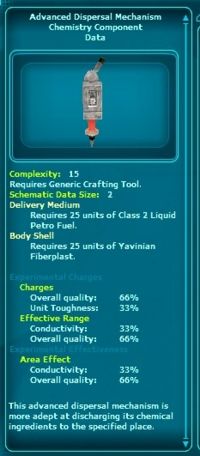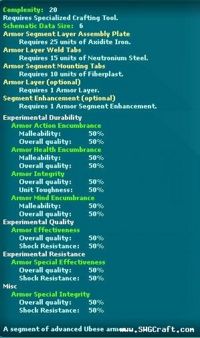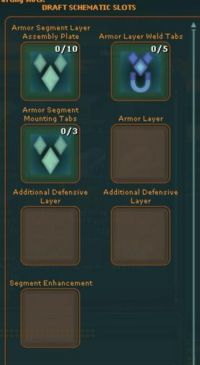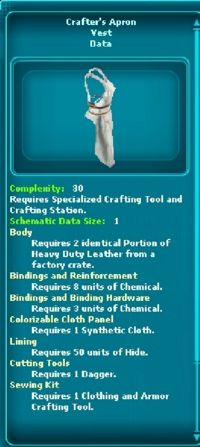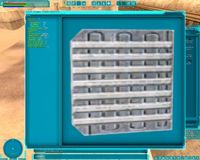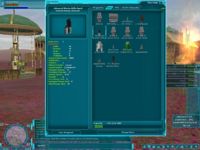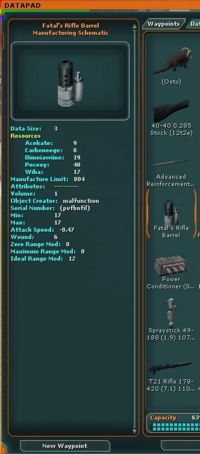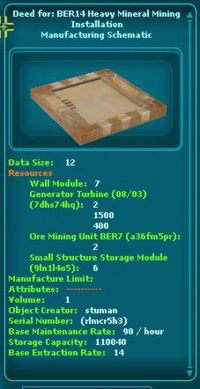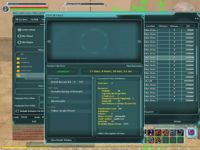Using Schematics (Game Mechanics)
| This article or section needs proper wiki formatting. |
Game Mechanics - Mechanics Category
SWGANH Wiki is a repository of Star Wars Galaxies Developer information. This site is only meant to be used by SWGANH Developer team.
|
|
General Draft SchematicSchematics are basically blueprints for anything you can build. They include designs for weapons and other devices, recipes for foodstuffs, and patterns for items of clothing. You Access your list of schematics through your Datapad (Ctrl+D). Double clicking on any schematic will bring up a description of that item, along with a list of the resources and other components required to build that object. Every item in the game requires specific components to craft. In many instances, these components will simply be resources. To craft a survival knife, for example, you might need several units of metal and a few units of polymer alloys. More complex items are actually composed from other crafted objects, or a combination of resource and crafted components. A blaster requires some resources, but also calls for a power cell, which is a separate craftable item. To build a blaster, you must first build (or buy) a power cell. Some items allow for optional components (you might be able to add spices to a meat stew or a scope to a rifle). The components are not required to complete the item, but may enhance the final product in some way. You can view the components required for any item by reviewing the object's schematic in your Datapad or through a crafting device.
Parts of General Draft Schematic1. Complexity
Complexity This stat governs several things. First it determines what type of tool and crafting station a player must use in order to have this schematic come up as an option to be crafted. Second, it determines the base length of production time in factories and in the crafting tools output production of a prototype item. The value listed within the schematic itself serves as a base figure. For every experiment attempt made (even if unsuccessful), this value is increased by one point.
This lists the minimum crafting tool type that must be used for a particular schematic. Schematics are linked in some cases to being used only by certain tools. Take for example Generic Crafting Tools and Lightsaber Crafting Tools. Both have some items in them with complexities of between 1-15. Generic tools can craft most objects ranging from 1-15 complexity. Due to certain items being restricted to certain tools; light saber items are craftable only by light saber tools,(even though it is 10 complexity). Specialized tools follow the same logic. A schematic that is designated to be used with a Structure and furniture tool can only be used with a structure and furniture tool, however since the structure is hierarchal, a lower tiered item can be crafted from a higher tier crafting tool in the case of the advanced dispersal mechanism below which only requires a generic crafting tool to create it, but in which a food & chemical tool can also be used to craft and experiment upon it. At times some schematics may even require both specific tools in addition to stations. This is likely linked solely to the complexity of the item where all objects of complexity 21 and higher would require a specialized tool in conjunction with a specialized crafting station (public or private depending on the complexity level) of that type.
This originally was intended to act as a sink for data pad points when a manufacturing schematic of this type was created. Each point in this would likewise take a point away from the datapad storage allotment, however in the NGE, all manufacturing schematics only take up one point.
1. Resource
In most cases Sub components directly add (or takes away from) to the item's stats. In these circumstances Components do not act as multipliers in the crafting process. For example a curved sword has a maximum experimentation range of 10-50 min damage and 100-255 max for min and max damage. If we add an advanced sword core that was experimented to have 25 min damage and 50 max damage, the minimum we could have on this weapon with 0% experimentation is 35-150. The maximum we would have after 100% experimentation would be 75-305. In some cases however, such as with chef container components for drinks, the item will act on a particular experimental property as a multiplier. Casks for example will add a 3x multiplier to the experimental quantity value for a drink. Using a small glass for instance would only use a 1x multiplier and thus keep the object's stats at the base amount.
Optional slots are like sub component slots in that they often require a crafted item, although in some cases loot items are accepted. Optional slots are just as their name says, optional. They are not required to complete the item however adding an optional component will affect the item by directly adding (or decreasing from) the item's stats and do not act like multipliers in most cases. In other cases, optional components can sometimes act as a multiplier to item experimental properties. One such case is with chef food additives in which will add or take away from the value obtained in an experimental property. For instance, a heavy additive for quantity will multiply the existing quantity attribute by 300-400% depending on the quality of the additive. An heavy additive for filling will reduce the existing filling amount on the item by 30-50%.
Architect:
Experimental Lines are what the player uses to allocate experimentation points into during the process of experimentation on an item. Experimental lines are made up of experimental properties. Experimental properties are the sub stats that are affected by the allocation of points. These stats are what give an item its usable properties and each property has its own resource weighting scheme based upon a percentage meaning the resource quality designated for that particular stat such as overall quality and shock resist for armor. In this case, the overall quality and shock resist of the materials used in the draft slots will be factored in with a 50/50 ratio to convert these resource stats into an experimentation rating ranging from 1 to 100%. Each property is checked individually on its own roll during the crafting process from assembly stage through to every experimentation attempt. This means that within the experimental durability line in armor for instance, there are 4 distinct rolls made each time a player allocates one experimentation point. Each roll has its own success chances and stats on the item can differ depending on the roll made for each attribute. If the player allocated all points at once then it is considered one attempt. In this case each stat would make one roll. Some items do not have experimentation lines, therefore these items do not have experimentation available to them. In other cases some items have experimentation lines which serve no purpose as the attributes allocated to them do not provide usable or relevant stats for the item being crafted.
Manufacturing SchematicsWhen using a generic crafting tool, you produce an actual object that can be used by you or others (a "prototype"). However, while at a crafting station and using a specialized crafting tool, you have the option of creating a manufacturing schematic instead. A manufacturing schematic can be used with factories to mass-produce the item.
Because the crafting session was saved off and the attributes are being reproduced, all of the same ingredients that were used to craft the manufacturing schematic must be used when the manufacturing schematic is used at a factory to run off more copies of the item. It's very important to remember that exactly the same ingredients must be used. For example, if the imaginary resource 'Benzoite', a type of Duralloy Steel was utilized to make a manufacturing schematic, then you'll need a supply of Benzoite to make items from that schematic. No other type of Duralloy steel will suffice. This also means that once Benzoite is no longer available in the universe, all manufacturing schematics that were made from it are no longer useable because the resource ingredient requirements can no longer be satisfied, and any desired manufacturing schematics will have to be created fresh using the currently available equivalent resource. The idea of identical ingredients being needed for making items from manufacturing schematics carries over into the realm of component ingredients for manufacturing schematics. The copies of the exact same component that was used to create the manufacturing schematic will have to be used to create items from that particular manufacturing schematic. The key point to note here is that since all the components have to be identical, they all have to have been produced in a factory themselves, as that's the only way to get truly identical items. For example, if a person generated a particularly good DL-44 blaster during the crafting process and decided that they wanted to be able to mass produce them in a factory, they'd need enough of the same resources that they used to craft the manufacturing schematic to meet the needs of how many copies of the blaster they wanted to make at the factory. If the imaginary ingredient "Terg's Blaster Power Handler Mark2" was one of the ingredients used, they'd need enough of those same blaster power handlers to make more blasters from the new DL-44 manufacturing schematic. They only way that those blaster power handlers could possibly truly be the same, is if they themselves had come from a factory assembly run. Thus, Manufacturing Schematics that require components should only be built off of components that came from an extended factory production run, because that's the only way you'll be able to satisfy the identical component ingredient requirements, and thus be able to build more objects.
1. Datasize
This is the same as in draft schematics. This originally was intended to act as a sink for data pad points when a manufacturing schematic of this type was created. Each point in this would likewise take a point away from the datapad storage allotment, however in the NGE, all manufacturing schematics only take up one point.
Resources Each manufacturing schematic will print out at the top, the list of harvested resources and components used in the item as well as the number of each that is required. The printed list component names and info are directly transfered from the components themselves, including any custom naming scheme the crafting placed. Additionally the serial numbers of the parts are added as well so as to give the crafter the ability to discern of how to match components that were run as part of a factory batch since it is possible for a crafter to have multiple variations of the same item. Schematics must use the same serial number for all parts. The resource and component list is sorted alphabetically.
Serial numbers & Attributes
Looted Components & Optional ItemsSee Loot Components for more information Looted SchematicsSee Loot Schematics for more information
Using Schematics In FactoriesSee Factories for more information. Source References
|
Bold text |
